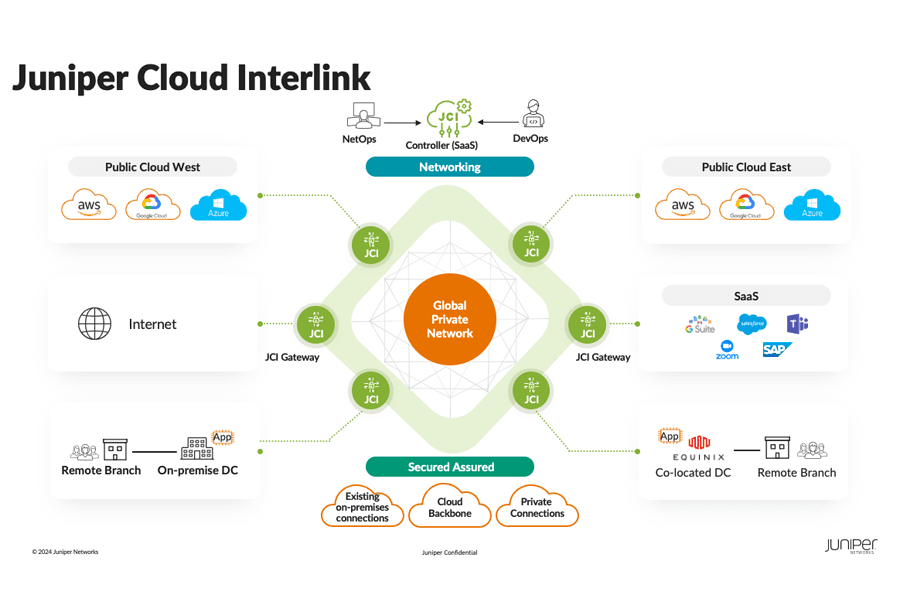Smart systems will help companies automate workflows and business processes, eliminate waste and inefficiencies, and improve decision-making and financial results. But they also introduce huge performance, security and reliability challenges for network architects:
- Performance. Enormous numbers of IoT endpoints will generate massive volumes of diverse application data and machine-to-machine traffic with unique characteristics and service requirements. IoT networks must provide the right SLA for the right application, at the right time.
- Security. In many cases IoT traffic will flow over the public internet. IoT networks must protect data privacy and defend IT infrastructure against malicious attacks.
- Availability. Many smart systems will be used in critical applications where downtime can lead to business disruptions, hazards or even loss of life. IoT networks must provide continuous connectivity to ensure critical applications are always available.
If you are planning an IoT initiative you’ll need to figure out how to address the increased performance, security and availability demands without breaking the bank. Conventional wide area networking products and legacy SD-WAN solutions are too expensive and inefficient for most large-scale IoT implementations.
Middleboxes and Legacy SD-WANs Introduce Technology Sprawl
Using traditional wide area networking and security products (routers, firewalls, VPN appliances, etc.) to build out IoT networks is a costly and complicated proposition. Each network element is deployed, configured, managed and maintained independently, which takes time and resources, and adds cost.
SD-WAN solutions can help reduce cost and complexity by eliminating middleboxes, virtualizing network functions and unifying administration. But legacy SD-WAN products are still expensive and inefficient. They instantiate each logical network element as a unique VNF that gobbles up CPU cycles and memory. To support a large IoT implementation an organization would end up having to purchase dozens, hundreds or even thousands of pricey multi-core servers.
Tunnel Overlays Prevent Traffic Management and Restrict Visibility
Conventional networking products and legacy SD-WAN solutions also use inefficient tunnel overlay schemes that inhibit traffic management and monitoring. They encapsulate all IoT dataflows into a single tunnel, treating all traffic identically. That means it is impossible to provide different SLAs for different workloads with different characteristics. It is also challenging to monitor or troubleshoot individual sessions to evaluate performance or isolate problems. To make matters worse, legacy networking solutions use high-overhead encryption protocols that eat up bandwidth and impair application performance, especially over capacity-constrained WAN links.
128T Session Smart Networking Slashes Cost and Complexity
128T Session Smart Networking removes inefficiencies and cost constraints so an organization can roll out large-scale IoT networks without breaking the budget. Our solution delivers multiple network functions (router, stateful firewall, WAN optimizer, etc.) in a single VNF, eliminating middlebox sprawl, while significantly reducing host CPU and memory requirements. As a result, our software runs on far less expensive COTS servers than legacy SD-WAN solutions.
128T Session Smart Networking meets stringent IoT performance, security and availability requirements:
- Performance. Our application-aware routing intelligently steers traffic based on policies and real-time network conditions, automatically selecting the right path for the right application at the right time. Granular QoS controls let you shape and prioritize traffic to enforce different SLAs for different IoT dataflows. And built-in bandwidth optimization features improve the performance of lossy or lower-speed WAN links.
- Security. Our unique Secure Vector Routing provides strong data security without the overhead of traditional encryption protocols like IPsec. We support a wide range of security capabilities including deny-all (zero trust) routing, Layer 3/4 DoS/DDoS protection, payload encryption, and NAT and VPN functionality. Our tunnel-free architecture lets you monitor and control individual IoT dataflows, so you can enforce SLAs, track KPIs and troubleshoot problems down to individual applications and sessions.
- Availability. The 128 Technology solution provides continuous connectivity without requiring expensive hot-standby tunnels like legacy WAN or SD-WAN solutions. If a link fails or an ISP experiences an outage, we can automatically redirect traffic over an alternative path without disrupting sessions.
The 128 Technology solution is ideal for IoT use cases like smart transportation systems or smart energy systems where sensors are deployed in distant locations and connected over suboptimal WAN links. For example, one of our customers is an oil and gas services provider that manages drilling equipment installed in offshore platforms and remote areas that are only reachable via spotty satellite connections or weak 4G data services. With 128 Technology, they expanded their available WAN capacity by as much as 900%, laying the foundation for a variety of digital oilfield applications. The new solutions help the company automate remote operations, reduce oil exploration and production costs, and improve safety and productivity.
To learn more about how 128 Technology can help your company reduce networking cost and complexity, and take full advantage of the Internet of Things, download our IoT solution brief.


